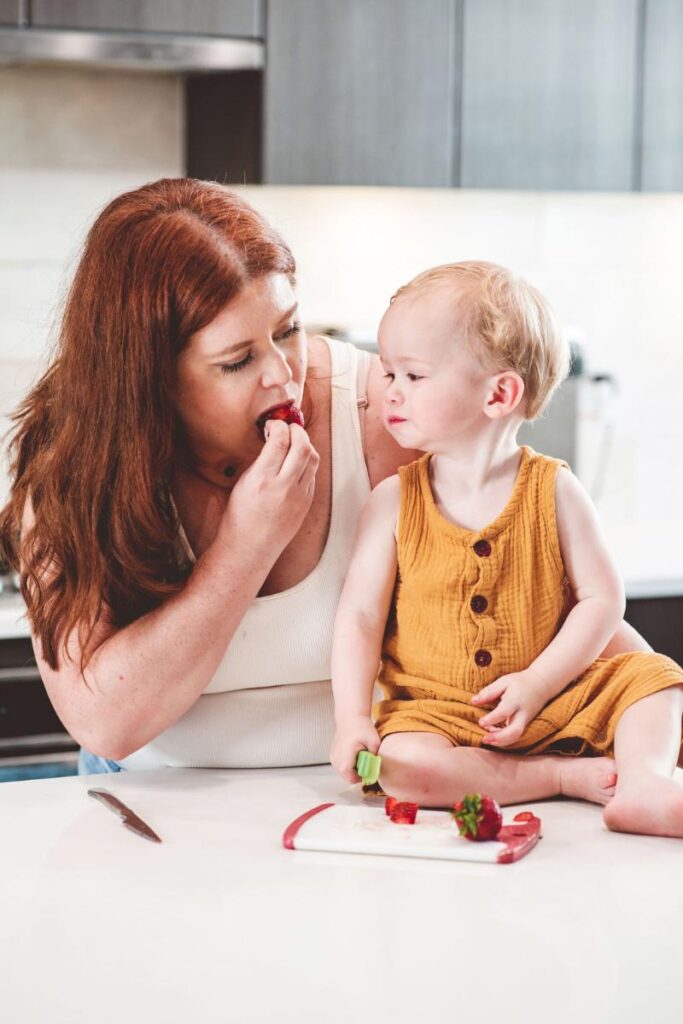If you’ve ever found yourself standing in the kitchen at night—chips, ice cream, or cookies in hand—wondering, “Why do I keep doing this?” you’re not alone. For many women, this pattern of comfort eating isn’t about greed, lack of willpower, or poor discipline. It’s a survival response.
Comfort eating shows up most often in women who spend their days holding everything together—managing careers, relationships, families, and endless emotional labor. From the outside, they look high-functioning. Inside, they feel depleted. And food becomes the one place where the body can finally let go.
As a binge eating therapist, I see this cycle every day. What feels like failure is actually a signal: your body is asking for attention, rest, and care. When you understand this, food stops being the enemy and starts becoming a messenger.
In this article, we’ll explore:
- Why emotional labor and caregiving often lead to comfort eating.
- How suppressing your emotions can turn into bingeing.
- What your late-night eating is really trying to tell you.
- And most importantly, how to begin breaking free with practical tools and compassionate support.
If you’ve been blaming yourself for comfort eating, take a breath. This isn’t about shame—it’s about learning to listen to what your body has been saying all along.
Hi, I’m Dr. Meredith MacKenzie, a binge eating therapist, intuitive eating coach, and creator of the One Body To Love program. If you’re feeling unsure about how to actually practice mindful eating or frustrated that it doesn’t look the way you expected, you’re not alone. This work is about connection, not perfection. I’d love to hear from you. You can reach out anytime or come connect with me over on Instagram for more real talk, resources, and encouragement.
High-Functioning, Highly Depleted: The Hidden Link to Comfort Eating
You’re responsible. You’re capable. You’re the one who keeps everything moving: career deadlines, family schedules, relationships, even the invisible tasks no one else thinks about. You’re the person others lean on, the one who anticipates needs before they’re spoken. And on the surface, it looks like you’ve mastered the art of balance.
But when I sit down with women in my practice, I often hear the same quiet confession: “I’m exhausted.” They’re pushing through every day without a pause to ask themselves what they need. Lunch gets eaten between emails, coffee goes cold in the car seat cup holder, and by dinnertime they’re running on fumes – too drained to think, cook, or connect.
And that’s when comfort eating takes over.
The eating happens quickly, often in secret, with a mix of desperation and shame. By morning, the promise to “get back on track” begins again. But the food wasn’t the real issue, it was the release. Comfort eating was the body’s signal: enough.
If you’ve ever wondered “Am I actually hungry, or just exhausted?” I created a free tool to help. Download my When You Can’t Tell If You’re Really Hungry Flowchart and keep it handy for those moments when comfort eating feels automatic.
This isn’t about willpower. It’s about depletion. When women are stretched thin, food becomes the most accessible way to self-soothe. A binge eating therapist can help untangle these cycles, not by adding more discipline, but by addressing the exhaustion underneath.

Emotional Labor and Comfort Eating: Why Women Disconnect from Their Bodies
“Emotional labor” gets tossed around a lot, but here’s what it really means: carrying the invisible weight of other people’s needs. It’s remembering your coworker’s birthday. It’s checking in on your friend who’s struggling, even when your own week feels impossible. It’s managing everyone’s schedules, moods, and meals – while still keeping your career and household moving.
If you’re also a mother, this is amplified tenfold. There’s no clock-out time. Even after bedtime, you’re the emotional anchor for your family. And that invisible responsibility often comes at a cost: your connection to your own needs.
This is where comfort eating quietly slips in. Because when your body has no pause button, food becomes the one place to release the weight you’ve been carrying.
Want to learn more about how stress impacts food choices? Read Breaking the Shame Cycle After Emotional Eating.
Caregiving, Capacity, and Why Comfort Eating Happens at Night
There are days when you truly want to move your body. You have your leggings on, your playlist queued, and your energy feels good. But then bedtime takes over. Another story. A meltdown. Dishes piled up. Lunches unmade. By the time you sit down, your emotional tank is empty.
For years, I beat myself up for skipping the workout. I told myself it was laziness, a lack of motivation. But it wasn’t laziness, it was capacity. And that same truth applies to food.
Many clients share that they eat “perfectly” all day, only to find themselves raiding the kitchen at night. That isn’t failure, it’s emotional suppression. After holding it all together, comfort eating becomes the body’s release valve.

If this feels familiar, working with a binge eating therapist can help you rebuild trust with your body and find ways to meet your needs without relying solely on food.

How Emotional Suppression Turns Into Comfort Eating
When you spend the day holding it all together, managing emotions, logistics, and everyone else’s needs, your body gets the message: my needs don’t matter. Hunger feels optional. Feelings feel inconvenient. And the tension builds.
When sadness, frustration, or even joy gets pushed down, your nervous system doesn’t ignore it. It holds it. And eventually, it demands release. For many women, that release shows up as comfort eating.
It might not feel like emotional suppression in the moment, but your body knows. It knows when you’re stretched too thin, when you haven’t taken a breath, when you’ve been last on your own list for too long. That late-night binge? The chips, the ice cream, the cookies you swore you wouldn’t touch? That’s not failure. It’s your nervous system saying: I need something. I need care.
Learn more in my When You Can’t Tell If You’re Really Hungry Flowchart.
What Women Aren’t Allowed to Say About Comfort Eating
In my sessions, I often hear women whisper truths they rarely say out loud:
“I’m tired of being the strong one.”
“I want something that’s just for me.”
“I can’t keep doing everything for everyone else.”
But those words come tangled with shame. Society teaches us that asking for space is selfish, that resting means you’re lazy, and that struggling with food is weakness. So instead of voicing what’s real, women push it down.
They say yes when they want to say no. They quietly manage the details no one else notices. They keep smiling, even through exhaustion. And eventually, comfort eating becomes the only outlet—a place where the body feels safe enough to finally receive something back.
A binge eating therapist can help reframe these patterns. Bingeing isn’t the problem—it’s a signal. It’s your body’s way of saying, I’m not okay. I need attention too.

Food Isn’t the Enemy—It’s the Messenger

If you see yourself in this, I want to offer a reframe: what if the eating that feels chaotic or shameful is actually your body asking for connection? What if comfort eating isn’t about sabotage but about survival?
Many of the women I work with discover that food is not the enemy. Instead, it’s a messenger. Every late-night snack, every moment of mindless eating, is a clue that the body has unmet needs. By shifting the lens from blame to curiosity, you can start to ask: What is my body trying to tell me?
Inside One Body to Love, this is the work we do. Together, we unpack the layers of exhaustion, guilt, and silence that have been living beneath the surface. We don’t rush to “fix” the food. We listen to it. Because food is often the language your body uses when words feel too hard.
This work takes time. It asks you to be tender with yourself in ways you may never have allowed before. But the freedom that comes from no longer fighting your body is worth it. And you don’t have to do it alone—support and tools are available to help you move toward peace with food.
Finding Support Beyond Comfort Eating
If comfort eating feels like the only way you can cope, you are not alone. So many women I work with carry impossible loads—managing households, caregiving, careers, and relationships—while pushing their own needs aside. Food becomes the release valve, not because you lack discipline, but because your body is asking for care.
The good news? You don’t have to keep navigating this cycle on your own. Start small by downloading my free When You Can’t Tell If You’re Really Hungry Flowchart. It’s a simple tool that helps you pause and understand what your body is asking for in the moment.
Curious about what’s shaping your eating patterns? Take the Eating Personality Quiz to learn more about your relationship with food. And if you’re ready for deeper support, explore Food Freedom in a Weekend or the year-long One Body to Love program.
As a binge eating therapist, I’d love to walk alongside you in this process, helping you build the skills and compassion needed to heal. Food isn’t your enemy, it’s your messenger. Let’s start listening together.
